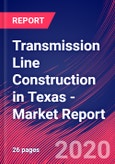High Frequency: Demand for New Telecommunication Infrastructure Construction Will Boost Growth<Br>
Transmission Line Construction in Texas
The Transmission Line Construction industry in Texas has experienced strong growth over the past five years. Growth has largely been driven by a strong electric power market in the state. The recovery of the state's economy has increased demand for electricity at the residential, commercial and industrial level, particularly in the energy-intensive manufacturing sector. Moreover, Texas has continued to shift away from coal-based electricity generation and towards more renewable energies like wind power. The growth of renewables has been a boon to the industry as these projects are typically higher-cost and thus more attractive to industry operators.The Transmission Line Construction industry is expected to grow at a slower rate over the five years to 2022. While organic growth is still expected to be moderate, uncertainty regarding regulations and borrowing costs are expected to limit investment in telecommunication structures. Demand from electric power markets is expected to continue to increase as demand for new renewable projects continues to rise. Moreover, even a shift to lower-cost natural gas projects would still do little to stop the advance of wind power within the state. Further, demand from telecommunications clients is also forecast to rise. Although the transition from wired services to wireless services will lessen over the next five years as a result of saturation, new technologies will still encourage companies to invest in new structures.
Operators in this industry provide construction, repair, rehabilitation and maintenance work for a variety of forms of electric power and telecommunications infrastructure, including power lines, power plants, radio and television towers and cable infrastructure. Industry operators, however, do not perform construction work on hydroelectric power stations, the construction of broadcast studios or electrical maintenance work within buildings.
This report covers the scope, size, disposition and growth of the industry including the key sensitivities and success factors. Also included are five year industry forecasts, growth rates and an analysis of the industry key players and their market shares.
Table of Contents
Companies Mentioned (Partial List)
A selection of companies mentioned in this report includes, but is not limited to:
- Quanta Services Inc.
- MasTec Inc.
- Dycom Industries Inc.
- H&M Shared Services Inc.
Methodology

LOADING...








